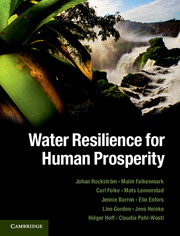Book contents
- Frontmatter
- Contents
- List of Contributors
- Preface
- Introduction to the book
- Acknowledgements
- Part I A new perspective
- Part II Living in a human-dominated world
- 2 Human modification of the Earth System
- 3 Balancing on a threshold of alternate development paths: regime shift, traps and transformations
- 4 Crucial functioning of and human dependence on the global water system
- Part III Food production globally: in hotspot regions and in the landscape
- Part IV Governance and pathways
- Glossary
- Index
- References
3 - Balancing on a threshold of alternate development paths: regime shift, traps and transformations
from Part II - Living in a human-dominated world
Published online by Cambridge University Press: 05 August 2014
- Frontmatter
- Contents
- List of Contributors
- Preface
- Introduction to the book
- Acknowledgements
- Part I A new perspective
- Part II Living in a human-dominated world
- 2 Human modification of the Earth System
- 3 Balancing on a threshold of alternate development paths: regime shift, traps and transformations
- 4 Crucial functioning of and human dependence on the global water system
- Part III Food production globally: in hotspot regions and in the landscape
- Part IV Governance and pathways
- Glossary
- Index
- References
Summary
This chapter addresses the involvement of water in abrupt and unexpected changes in social–ecological systems. It looks more closely at water’s many roles in reinforcing processes and stabilising feedbacks, and how systems suffer when feedback processes weaken or break. It discusses water-related disturbances and feedbacks, different categories of regime shift and ways of enhancing resilience. The issue of traps is discussed, both green water-related poverty traps, involving self-enforcing mechanisms, and blue water-related rigidity traps, when people and institutions resist change. The chapter explains the use of transformation management to get out of traps.
Rapid, accelerating and surprising changes in the Anthropocene era
Many of the changes in the GWS are rapid and can be surprising. Some are accelerating, but change can also be smooth and gradual. Most importantly, some change can be turbulent and abrupt, and result in non-linear responses from human, economic or ecological systems, with effects that are difficult, if not impossible, to reverse. Documented cases include the collapse of marine cod fisheries in 1992 (Hutchings, 1996), the collapse of Saharan vegetation 6–8000 years ago (Foley et al., 2003) and the financial crises of 2008, all of which caused rapid and unprecedented reductions in resource availabilities with abrupt, unforeseen and negative effects on human well-being.
The Anthropocene era has seen an increase in the links between humans and the environment, at multiple scales. Freshwater plays a significant role in this context, through its capacity to link different systems and places. Intricate cross-scale interactions play out in novel ways, which connect distant peoples and places (Adger et al., 2008; Galaz et al., 2010) reshaping the capacity of the biosphere to sustain human well-being (Folke et al., 2011) and increasing the risk of abrupt change.
Information
- Type
- Chapter
- Information
- Water Resilience for Human Prosperity , pp. 68 - 93Publisher: Cambridge University PressPrint publication year: 2014
